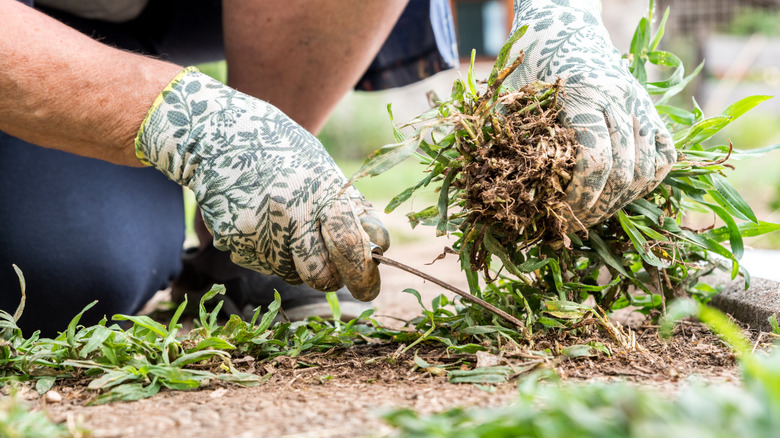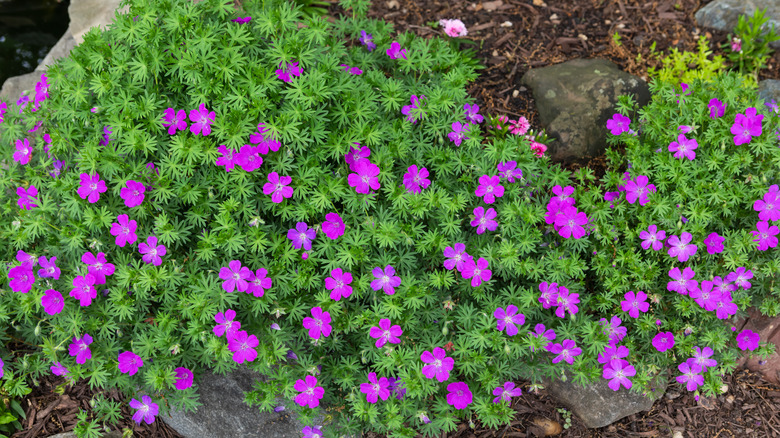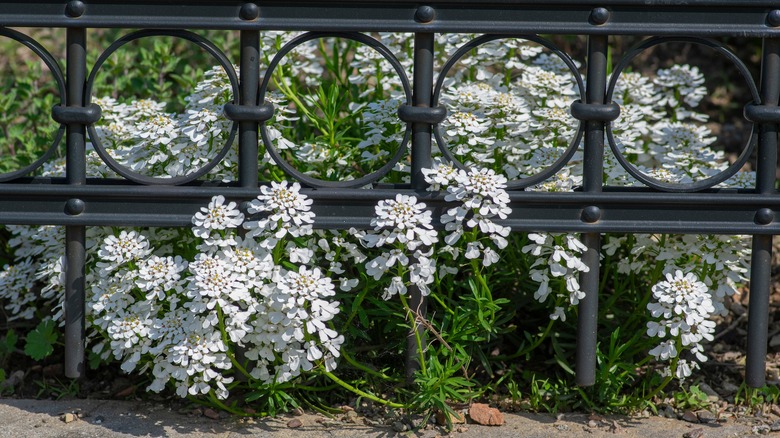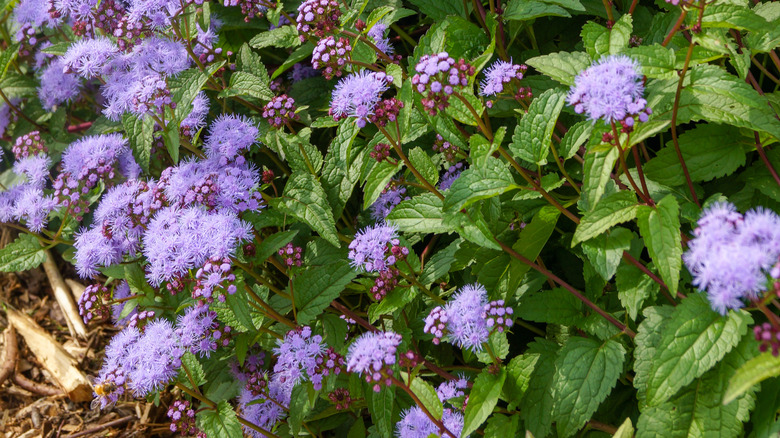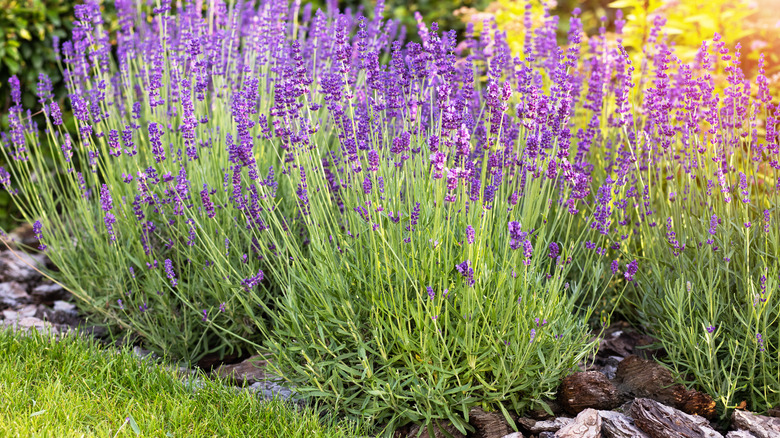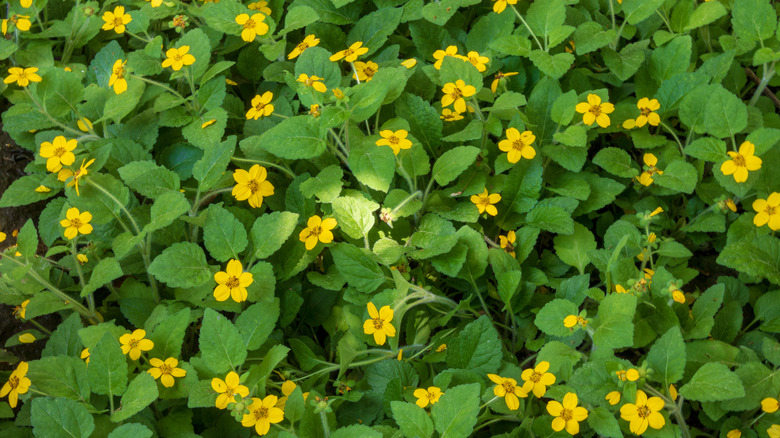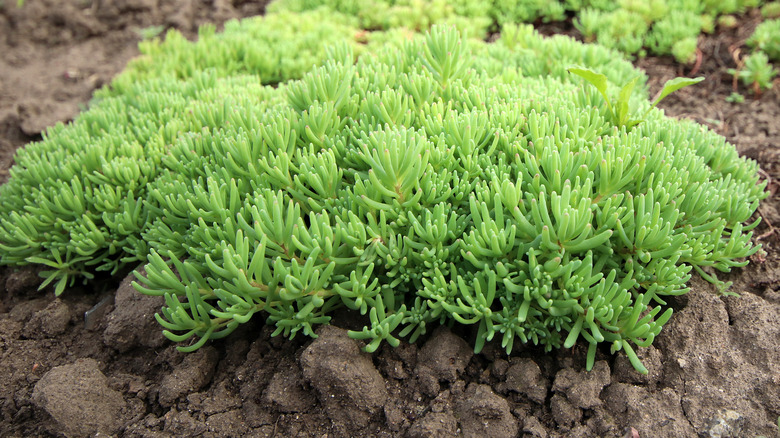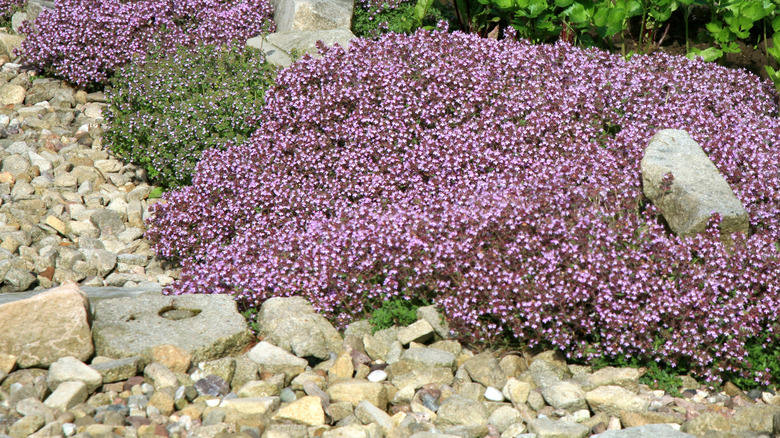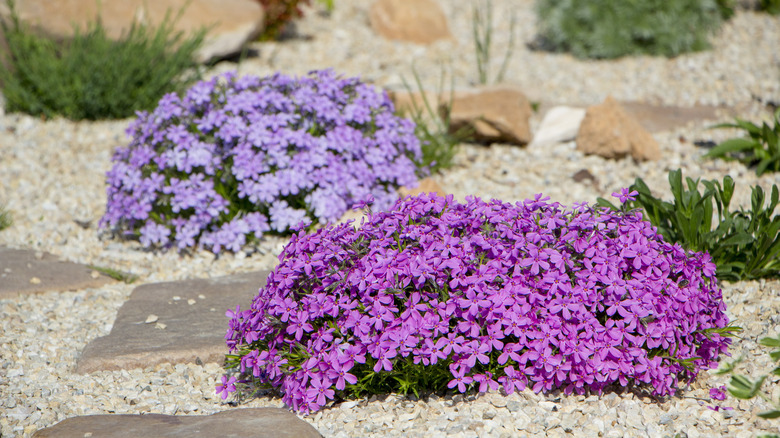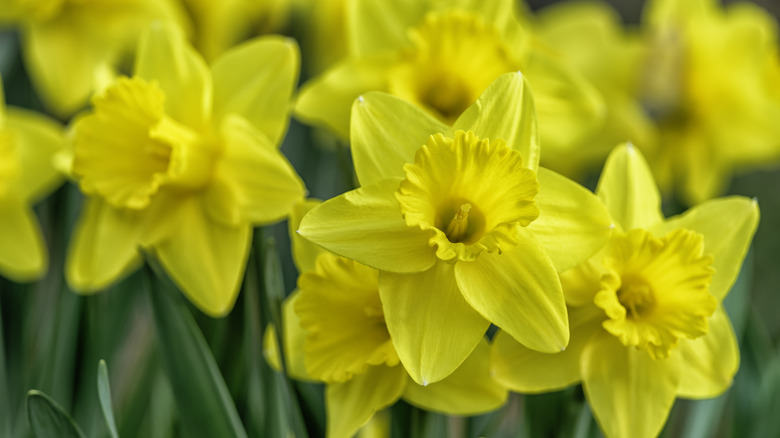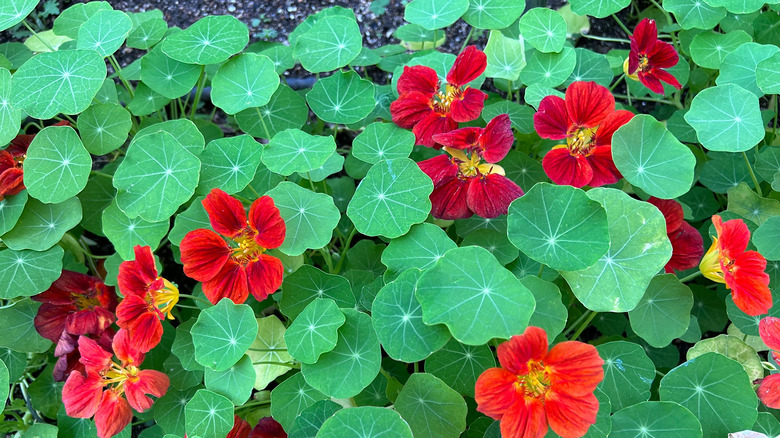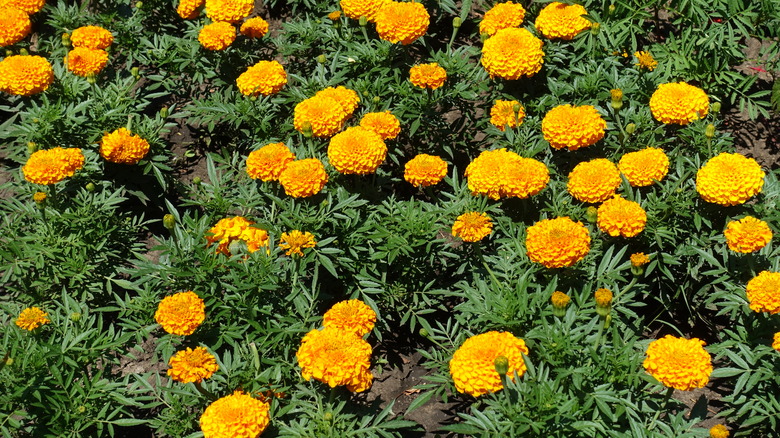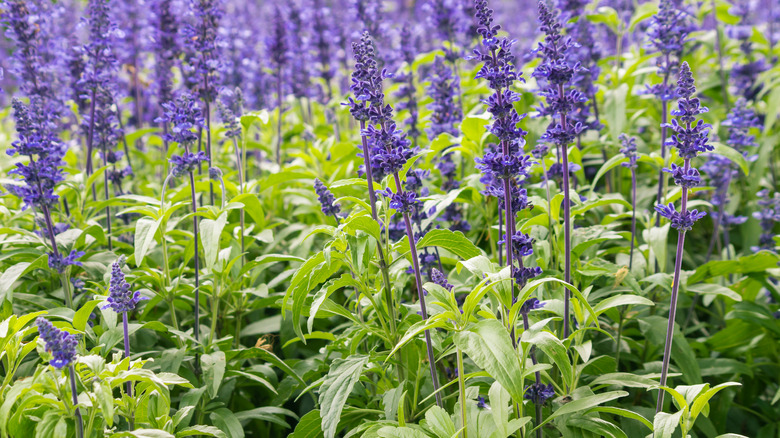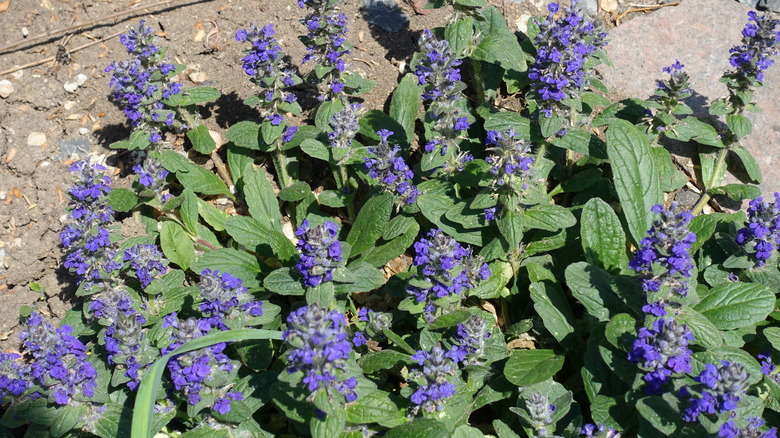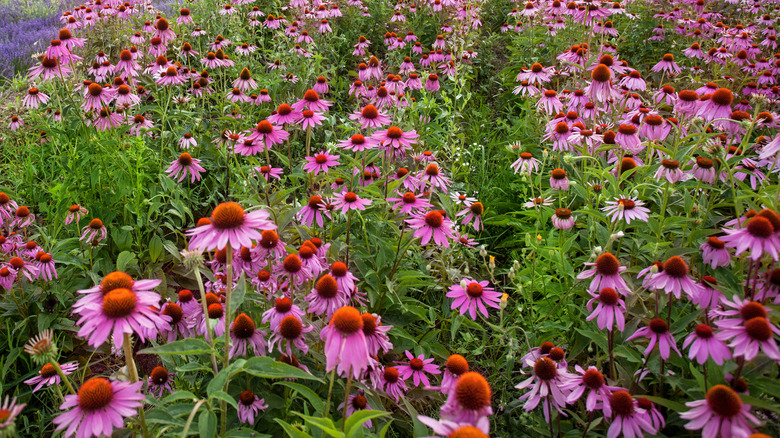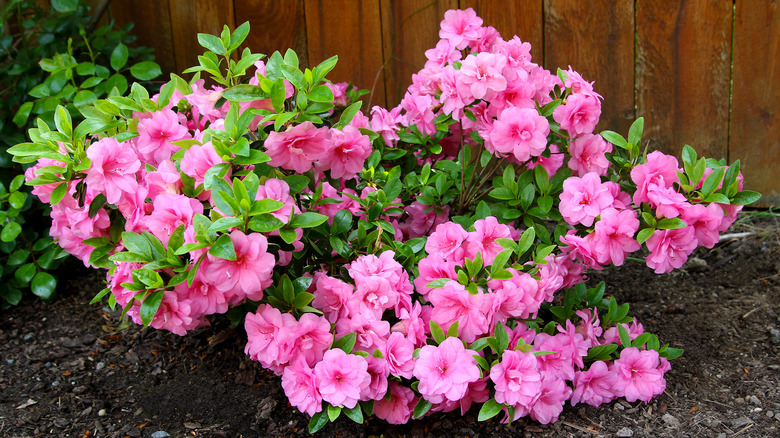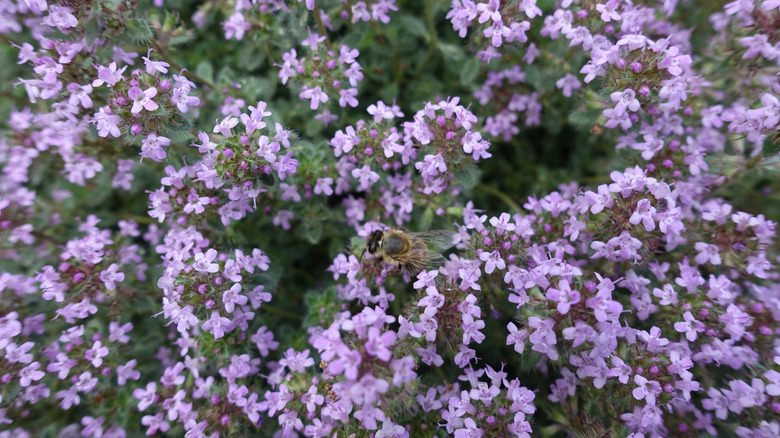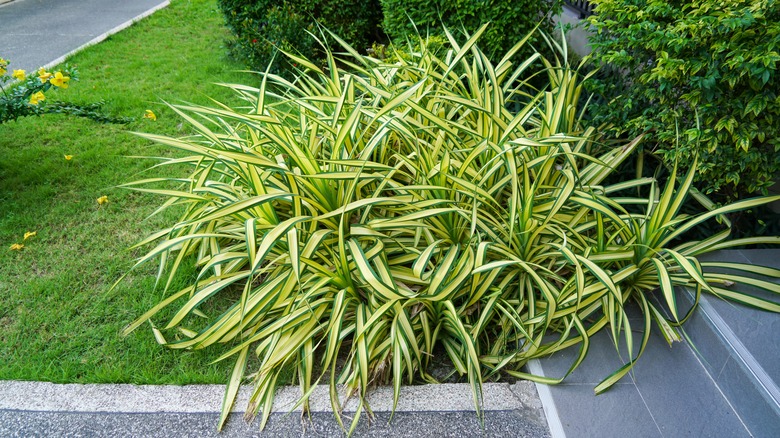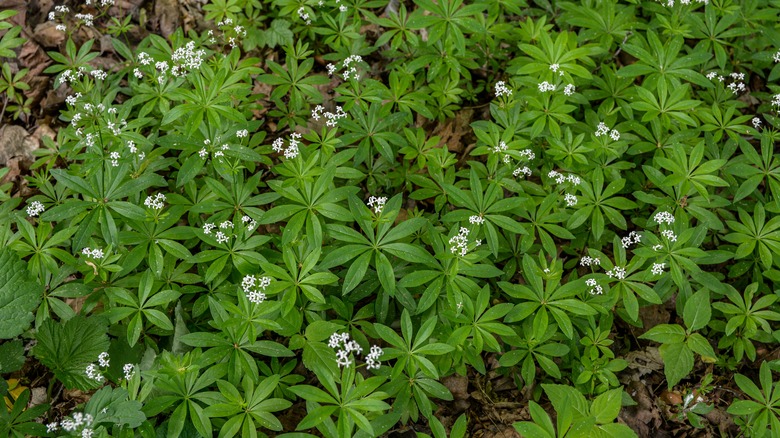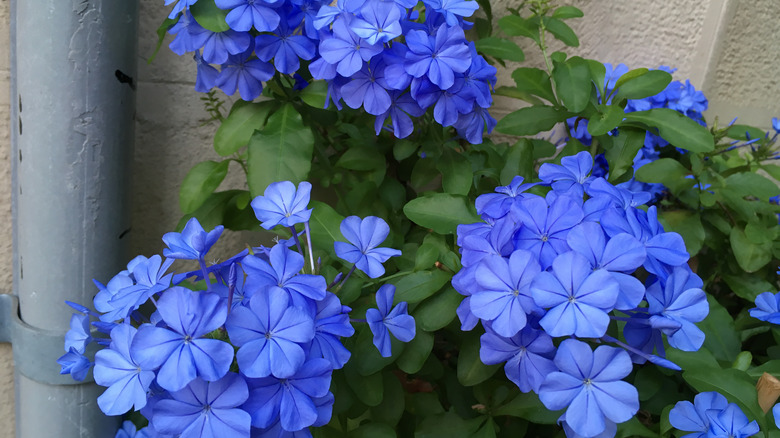20 Beautiful Plants That'll Help Prevent Pesky Weeds In The Garden
Ah, the struggle with those pesky weeds making themselves at home in your garden, hogging all the goodies — sunlight, nutrients, moisture, and even the room to breathe — earmarked for your favorite plants. But imagine if your garden could fight back with its own brigade. Yes, nature has a solution up its sleeve, and it comes in the form of groundcover plants. These botanicals double as a living mulch, creating a lush barrier that chocks out green invaders. However, they're not just about defense; some are pretty snazzy, dolling up your formerly dull garden with flashy foliage or seasonal blooms. Here, we'll cover 20 beautiful groundcover plants that will prevent weeds from taking over your garden.
Moving onto the heavy hitters — plants like sweet clovers and plumbagos aren't your average ground covers. They possess a secret weapon called allelopathy, where they discharge chemicals that halt nuisances like kochia and stinkweed in their tracks. And guess what? Virtually all the ground huggers in this list are also a magnet for pollinators, which is great news for nearby fruiting plants. And by growing these green mats, you can pretty much forget about soil erosion. Plus, a bunch of them bring to your table a bounty of edible foliage, enriching not just the soil, but your meals as well. When mixing these groundcovers with your regular crops, you want to set up a time when weeds just stop being a problem, ideally post-critical growth phases or right after harvest.
1. Hardy geranium
Looking to take down those unwelcome plants but still keep things looking cheery? Meet the hardy geranium (Geranium 'Dilys'), potentially your new garden BFF. This perennial comes decked out in green and its sprawling habit means you've got the groundcover game on lock. It blooms with funnel-shaped flowers that splash your garden in shades of purple and lavender. If aiming for peak performance, pick a sunny or partially shadowy spot with well-drained soils in USDA zones 4 through 8. That's not all! A bit of snipping off stems and deadheading faded flowers can keep the floral show going in spring and late summer.
2. Candytuft
If you're seeking a beautiful early-blooming flower for your spring garden, candytuft (Iberis sempervirens) is a champ you can't afford to overlook. This annual forms a dense mat that covers the soil, practically thwarting weed growth. And those dainty blossoms? They come in hues of white, pink, and red, sprinkling your garden with a romantic vibe. They're also a magnet for pollinators, bringing your garden to life. To grow this natural weed bouncer, sow seeds directly in well-drained, slightly alkaline soil in its goldilock zones 6 through 9 with total and partial exposure to the sun. However, ensure 12 to 18 inches of spacing between them.
3. Blue mistflower
Blue mistflower (Conoclinium coelestinum) is a multi-stemmed perennial that steps up as a colonizing groundcover and pulls in the looks and local bees with its blue-purple blooms that pop from July to November. Tossing some seeds directly into the soil in fall is your best bet here, though playing around with cuttings in late spring can work too. Just remember they love soaking up the sun and kick it in loose, well-drained soil in zones 6 to 9. After its show is over, give the plant a good trim in late winter to clear out the old and say hello to fresh growth.
4. Lavender
Lavender (Lavandula angustifolia) is a woody, drought-resistant perennial that forms a backdrop of dense gray-green foliage, setting the stage for the main event in summer. That's when lavender struts its stuff, flaunting spikes of the most captivating purple to pink flowers. It's not just a pretty face, though. These plants grow in tight batches, giving ground-level weeds the cold shoulder. And the fragrance? Pure garden magic, adding an extra layer of zest to your yard. Give it some sun and slightly alkaline soil in USDA zones 5 through 9, and it'll repay you with beauty, all while keeping green invaders at bay.
5. Green-and-gold
Green-and-gold (Chrysogonum virginianum) is a ground-covering perennial with lush, semi-evergreen foliage that works year-round to keep your garden looking full and lively. The charm of its star-like, yellow flowers isn't just visual — they have a practical role too, serving as a busy little café for bees, songbirds, and other pollinators. Not to mention, the seeds from these blooms are a snack for birds. Green-and-gold is partial to the shade, meaning less sun is more beneficial for it. Make sure your soil is well-draining and slightly acidic, and if you're in zones 5 through 9, you've hit the jackpot.
6. Stonecrop
Another logical choice for beautiful plants that prevent pesky weeds in the garden, stonecrop (Sedum) lights up your garden with 1-inch, star-shaped flowers with shades of white, yellow, to pink blooms. They also lure pollinators, ramping up the produce of nearby fruiting plants. But the magic doesn't stop with their looks; those evergreen leaves grow densely and low, keeping out unwanted weed guests by hogging all the sunlight and space. Stonecrop is happy in USDA zones 3 through 9 and slightly alkaline soil and can handle drought. Just make sure you don't leave it sitting in poorly drained or waterlogged soil.
7. Thyme
Not just a fragrant culinary delight and a weed-suppressing ground cover plant, thyme (Thymus) can double as a natural artist, adding a touch of whimsy to your rock walls with its trailing nature. Plus, picture its charming little blooms in shades of white and purple breathing life into your garden space and summoning bees and butterflies. To see it thrive, plant it in well-drained soil that leans on the alkaline side and let it bask in the sunshine. It's pretty chill when it comes to upkeep, happy in USDA zones 5 to 9, and asks only for an occasional snip to stay lush yet compact.
8. Creeping phlox
Weeds hardly stand a chance beneath the dense foliage of the creeping phlox (Phlox stolonifera). When spring rolls around, it's like a switch flips and boom — your garden's awash with a colorful burst of purple, white, pink, and blue flowers that are like a magnet for friendly pollinators. A native groundcover, creeping Phlox feels right at home in soil that's just a touch on the acidic side and well-drained in USDA zones 5 through 8. It's an excellent addition to small rock gardens with exposure to full sun and partial shade. Once established, pruning will suffice to keep the air flowing and ward off powdery mildew.
9. Daffodils
How about you toss some daffodils (Narcissus pseudonarcissus) into the mix of your botanical weed busters? Between December and May, these beauties will spice up your garden with their yellow, white, or orange flowers. Packing a punch against weeds with their sprawling clumps, daffodils are pretty chill about where they grow, as long as the soil is slightly acidic and they get a good mix of sun and shade in USDA zones 3 to 10. However, keep an eye on curious children and furry friends, because munching on this plant isn't a good idea — it's toxic, according to the National Capitol Poison Center.
10. Nasturtiums
Nasturtiums (Tropaeolum majus), with their fiery orange, red, and yellow flowers, are another go-to for livening up a lackluster garden while tackling those pesky weeds. These vibrant plants thrive in slightly acidic to neutral soil and enjoy full sun to partial shade. Suitable for balmy zones 9 through 11, nasturtiums create a colorful ground cover that not only suppresses weeds but also attracts plenty of pollinators. What's more, their leaves and blooms are edible. Plant the seeds once the spring soil is warm, space out the seedlings about 12 inches apart, and keep up with deadheading for extended blooming.
11. Mexican marigold
Highly acknowledged natural pest repellents, Mexican marigolds (Tagetes erecta) are pros at stealing the show in gardens. From early summer to fall, and with a little upkeep by sniping spent flowers, they flaunt blooms ranging from gold, fiery oranges, to vibrant reds. Along with brightening up any spot that's feeling a bit blah, these plants churn out a special chemical that suppresses root-knot nematodes. Give them a sunny to partially shady spot and well-draining soil that leans on the acidic to neutral side in USDA zones 2 through 11. Also, spread them out 12 inches for that natural, weed-suppressing ground cover.
12. Sage
Sage (Salvia officinalis) is a culinary powerhouse that doubles as an attractive, bushy perennial. Its silvery-green foliage spreads out, creating a natural barrier against those green invaders you'd rather not host. Come summer, sage puts on a show with its blooms in hues of blue or pink, which are not just pretty but also edible, complete with a hint of camphor scent. Planted in sunny to partially shadowy locations with well-drained soil, sage thrives, forming a dense mat that keeps the weeds at bay. It's happiest in USDA zones 4 to 10 and will need a trim as spring rolls in.
13. Ajuga
Next up on the best plants to prevent weeds, we meet Ajuga (Ajuga reptans), a charming ground-hugging perennial that snugly carpets the soil with lovely rosette formations. It's not only practical but pretty too, boasting spikes of bluish-purple flowers that draw in pollinators and brighten up your garden in spring. Happiest in USDA zones 4 to 10, Ajuga can handle partial sun to deep shade and prefers its soil well-drained and slightly acidic. Taking care of this hardy ground cover that's also deer-resistant is pretty straightforward. Just give it some room to breathe to avoid powdery mildew and crown root.
14. Echinacea
Looking for a ground cover that brings both charm and a dash of health to your garden? Say hello to echinacea (Echinacea angustifolia). Better known as coneflower, this plant is decked out in pink and lavender, cone-adorned flowers that bees, songbirds, and butterflies can't resist. These hardy bloomers are just right for well-drained and sunny to partially shadowy spots that lean on the slightly acidic to neutral side in USDA zones 4 through 8. Coneflowers are a breeze to care for once they take root, can stand up to dry spells, and a little deadheading and stem trimming will keep the blooms coming.
15. Azalea
Groundcover azalea (Rhododendron nakaharai) is an outstanding weed deterrent that adores a spot where the soil is just the right amount of acidic and the drainage is on point. They're not sunbathers but they know how to put on a show with pollinator-drawing blooms of varying shades. Azaleas are quite tough on the invasion of unwelcome plants, thanks to their tendency to spread out more than reach for the sky. Spring or fall is the ideal window for getting azalea into the ground. However, watch out for their kryptonite — root rot — and thus keep their root balls near the ground level.
16. Goldmoss
Looking for a soft, fuzzy living mulch that chokes out weeds? Why not give Goldmoss (Sedum sarmentosum) a shot? This little gem rolls out a carpet of bright yellow-green leaves, crafting a thick tapestry that's a no-go zone for sunlight. But it's not all defense; Goldmoss brings its A-game with a discreet sprinkle of yellow, star-shaped flowers peeking out from the woolly foliage in summer. Talk about a low-maintenance weed suppressor that favors full sun and thrives in the chilly zone 3 to the balmy zone 9. It doesn't throw a fit over soil quality, either, and will do its thing in less-than-ideal soil conditions.
17. Woolly thyme
Got a patch in your barren garden that's vulnerable to weeds but could use a splash of beneficial life? Consider woolly thyme (Thymus praecox), a broadleaf evergreen that spreads out into a lush carpet of blueish-green dotted with adorable pink to lavender flowers in early summer. It doubles as a pollinator magnet, all while giving a cold shoulder to pests, diseases, and deer. Plant the seedlings 6 to 18 inches apart under the sunshine within USDA zones 5 to 8, and watch them do their magic. If fancying a low-maintenance lawn alternative, woolly thyme's got your back, too, although it's not a fan of heavy foot traffic.
18. Ice dance carex
You might mistake it for your run-of-the-mill grass, but ice dance Carex (Carex morrowii) is part of the sedge family that sends out underground runners to form dense, evergreen clumps that keep those pesky, uninvited plants at bay. Plus, it's an ornamental guest, flaunting variegated leaves and bringing along subtle brown blooms in the late spring. Springtime is also the perfect moment to divide this sedge. It's pretty low-maintenance, and pests and diseases rarely crash its party. Just tuck it into a comfy spot with moist soil, where the light is somewhere between a deep shade and a gentle sunbeam in zones 5 through 9.
19. Sweet woodruff
Sweet woodruff (Galium odoratum) is a low-growing, flowering perennial that creates a lush, green mat that gives off a pleasant fragrance and is accented by clusters of white flowers in spring. Among the easy-to-grow ground cover plants that thrive around tree roots, it loves its soil moist and well-drained soil and appreciates watering during parched weather. From February to May, it's your window to sprinkle those seeds just beneath the soil's surface. Sweet woodruff knows how to make itself at home pretty fast with its network of shallow roots. However, a cut here and dig there with a spade is all it takes to keep it where it's needed.
20. Blue plumbago
Rounding off our compilation is one of the best low-maintenance ground covers: the real stunner that is blue plumbago (Ceratostigma plumbaginoides). This plant is a chill spreader, crawling beneath the earth with rhizomes, but never really tipping into the invasive territory. Come summer, plumbago hits the stage with a floral show that swings from lavender-blue to purple. This ground cover has a go-with-the-flow attitude for soil pH and does well in hardiness zones 4 through 8 under full to partial sun. Plus, it's the kind of laid-back plant that keeps its blooms fresh without a fuss — no need to snip off the wilted stuff.
